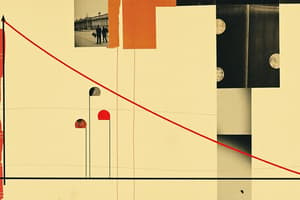Podcast
Questions and Answers
What are the five determinants of demand?
What are the five determinants of demand?
The price of the good or service, the income of buyers, the prices of related goods, the tastes or preferences of consumers, and consumer expectations.
What does a demand curve look like?
What does a demand curve look like?
A graphical representation of the relationship between the price of a good and the quantity demanded.
Why does the demand line move to the right or left?
Why does the demand line move to the right or left?
When factors other than the price of the product alter.
What does a demand curve with increased demand look like?
What does a demand curve with increased demand look like?
How do economists identify the effect of price changes on demand for any good?
How do economists identify the effect of price changes on demand for any good?
What do economists refer to this assumption as?
What do economists refer to this assumption as?
What are the determinants of demand other than price known as?
What are the determinants of demand other than price known as?
What must be done once we have drawn our demand curve?
What must be done once we have drawn our demand curve?
What is an increase in demand and how does it look on a demand curve?
What is an increase in demand and how does it look on a demand curve?
What are complementary goods?
What are complementary goods?
What are substitute goods?
What are substitute goods?
What are inferior goods?
What are inferior goods?
What are giffen goods?
What are giffen goods?
What are the causes for an increase in demand?
What are the causes for an increase in demand?
What is a decrease in demand?
What is a decrease in demand?
Flashcards are hidden until you start studying
Study Notes
Determinants of Demand
- Five key determinants: price of the good/service, buyer's income, prices of related goods (complementary or substitute), consumer preferences, and consumer expectations.
Demand Curve
- Graphical representation showing the relationship between the price of a good and the quantity demanded.
Shift of Demand Line
- Demand line shifts right or left due to changes in factors other than the product's price.
Increased Demand Representation
- Increased demand is illustrated by a "before and after" diagram where the original demand curve (D1) shifts to a new curve (D2) due to changing demand conditions.
Identifying Price Effects on Demand
- Economists isolate the price effect by assuming all other determinants remain constant, allowing clearer analysis of demand shifts due to price changes.
Ceteris Paribus Assumption
- Latin term meaning "other things remaining the same," used by economists to focus on the effects of price changes while holding other factors constant.
Conditions of Demand
- Factors other than price that affect demand are referred to as conditions of demand.
Examining Demand Curve Changes
- After drawing a demand curve, it is essential to assess how changes in the conditions of demand would shift the curve.
Increase in Demand
- Characterized by greater quantity demanded at every price level, depicted as a rightward shift on the demand curve, resulting in a new parallel line.
Complementary Goods
- Products that are used together (e.g., fish and chips); a decrease in the price of one leads to an increase in demand for the other.
Substitute Goods
- Alternatives for one another (e.g., tea and coffee); if the price of one increases, demand for its substitute may rise, even if its price remains unchanged.
Inferior Goods
- Goods that see decreased demand as consumer incomes rise; for example, people may buy less mince if they can afford steak.
Giffen Goods
- Staple goods that may see increased demand when real income decreases, despite potential price increases (e.g., buying more potatoes than meat).
Causes for Increased Demand
- Demand for a good rises with: an increase in consumer real income, a favorable change in taste, a price increase of substitute goods, or a price decrease of complementary goods.
Decrease in Demand
- Refers to less quantity demanded at each price; represented in a demand curve as a leftward shift, creating a new parallel line.
Studying That Suits You
Use AI to generate personalized quizzes and flashcards to suit your learning preferences.




